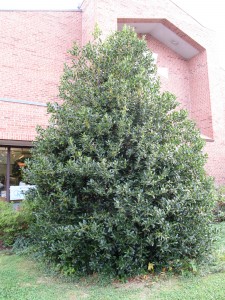‘Nellie R. Stevens’ (‘NRS’) is a tall growing red fruited female holly, a cross between the English (Ilex aquifolium) and Chinese (I. cornuta) hollies. ‘NRS’ comes highly recommended for Southern Appalachian landscapes (USDA zones 6 and 7).
Hollies are dioecious, requiring both male and female parents for fruit production. ‘NRS’ holly produces small numbers of seedless parthenocarpic fruits without a male pollinator being present. More fruits are produced naturally when ‘NRS’ is properly mated to the male cultivar such as ‘Edward J. Stevens’ and another I. cornuta holly. One male holly adequately pollinates 8-10 female plants located within several hundred feet. Red fruits are not as persistent as ‘Emily Bruner’, another holly favorite.
Hollies are spaced apart according to their intended use in a planting. ‘NRS’ is an outstanding “stand alone” specimen or you can hedge several together to form a tall privacy screen. Annual growth rate is moderate, about half that of Leyland cypress (x Cupressocyparis leylandii). ‘NRS’ holly is a lot more dependable and long-lived.
‘NRS’ is a strong grower at 25-30 feet tall and 15-18 feet width over 30 years. If planted as a privacy screen, plant on a minimum of 12 foot centers (between plants).
Hollies prefer an open sunny location and moderately acidic, well-drained soil. Established hollies are good foragers for nutrients and benefit from annual feeding with an acidic based fertilizer such as Hollytone®, Miracid® or Miracle Gro®.


 Posted in
Posted in 
